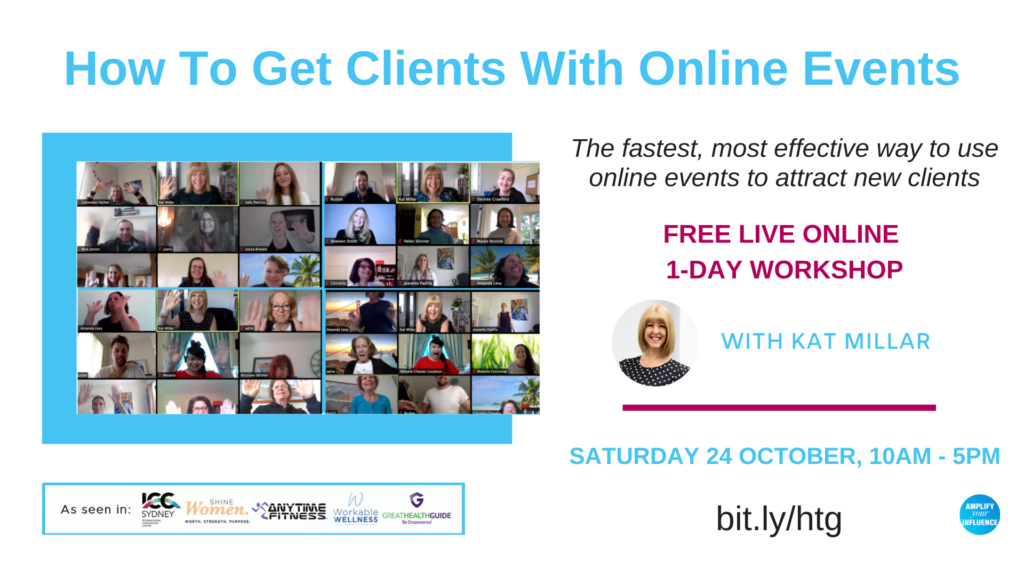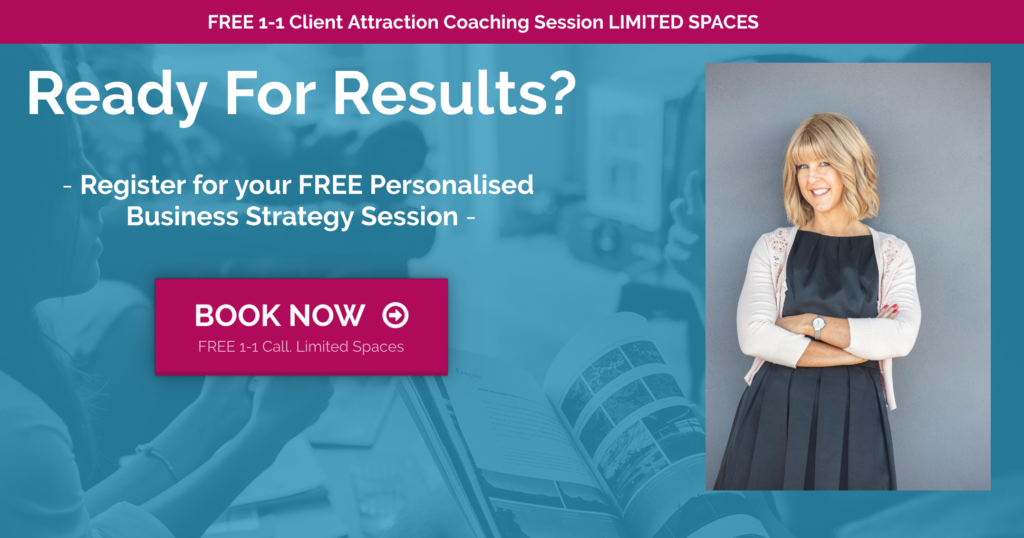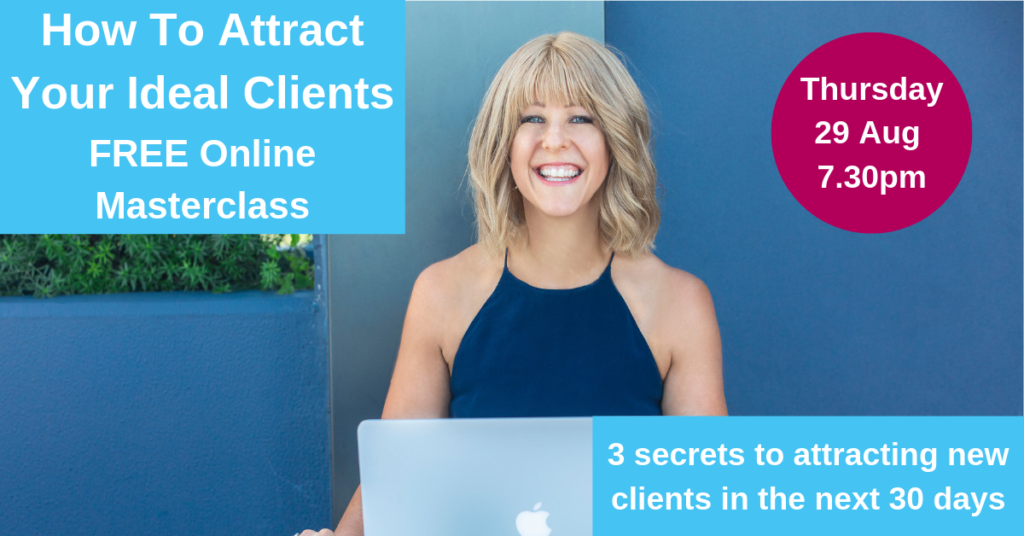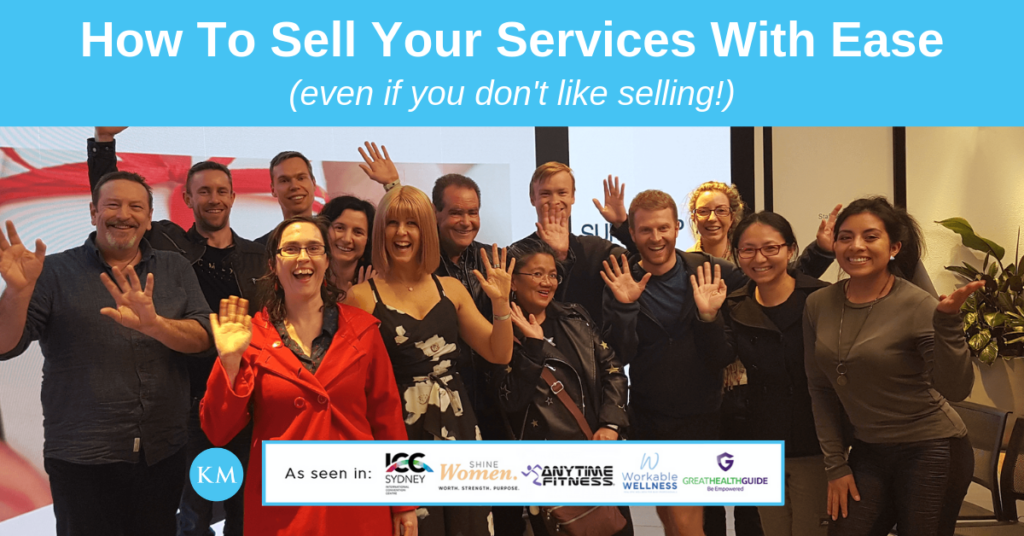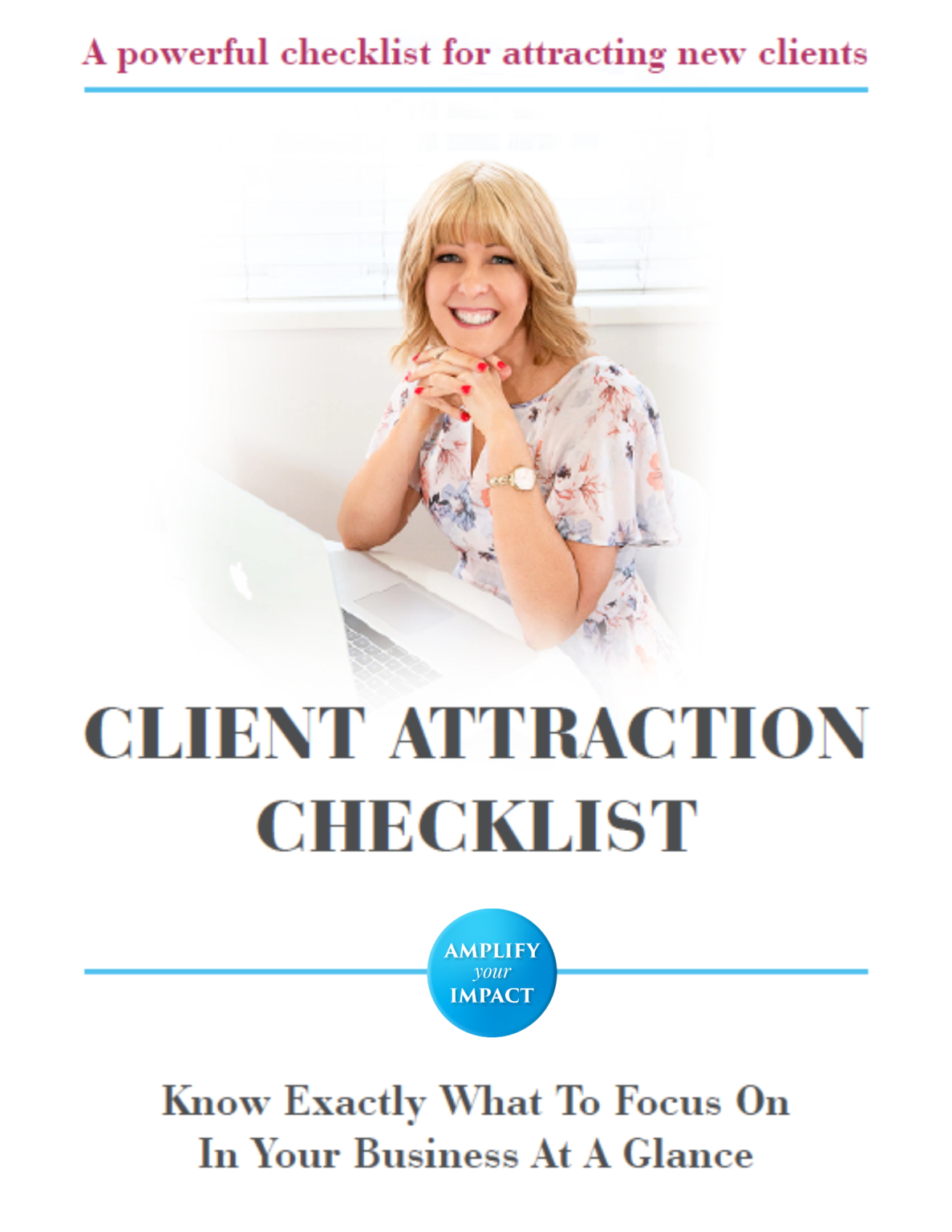How To Go From Slow To Supercharged In Your Business
I recognise them immediately because they’re the same mistakes I made when I was first starting out.
If you’re not currently making a healthy profit in your business (like having 5 figure months) in a way that FEELS GOOD…
And doesn’t take up all your available free time…
More than likely, it’s because you’re making at least one of these common mistakes.
Here’s the good news: In my latest article and video, I tell you exactly WHAT to do INSTEAD!
It will take you from feeling like you’re pushing a bike up the hill… to racing ahead in a fast car.
The mindset of a successful entrepreneur is to go where your competitors aren’t willing to go.
It’s your choice.
If you’re trying to speak to everyone, and you’re not speaking directly to your ideal clients, they probably won’t find you or be helped by you.
The more that your content helps your ideal clients to understand and overcome their pain-points, the more likely they will want to work with you.
People want to work with masters of their craft – people who have honed their skills in a specific area.
Your market is CRAVING an in-person connection with someone who gets them.Doing ONLY online marketing is an easy, comfortable way to do business.
But it rarely works for the majority of Coaches and Service-based Business Owners.
People want to buy from a human being they know can help them—not with random pages on the internet.
If you’ve got a great message to share, one of the best ways to do it is to run your own workshops.
When you only send people to your website or social media handles, there are many distractions.
People can get caught up reading articles and watching videos, rather than opting in to your email list.
The most important asset that you have in your business is an email list – a database.
You set up the freebie on a landing page and then create a follow-on email nurture sequence that people go to that leads them to your paid offer.
When you send them to a specific landing page with a freebie for them, and they opt-in, they are more likely to become a client.
Landing pages convert 4-10x higher than a website.
So, if you honestly look at the way you’re running your business right now…
Do you see yourself making any of these mistakes?
I’ve been there.
And that means I know how to get out. 🙂
The exact step‐by‐step roadmap is inside of my intensive and intimate 12‐week coaching program—Amplify Your Influence Accelerator.
And I want YOU to be in it!
There are LOTS more details I want to share with you.
And it’s all on this next page
I hope you’ll join us so I can show you how to set your business up the right way…
And YOU can enjoy 5‐figure months (or MORE!).. with EASE! 🙂
Kat
How To Have The Body Language Of Confidence
Have you noticed how one person can appear super confident, while another person comes across as unconfident – even if both people are saying similar things?
Confidence is not just about what we say, but what our body is saying as we say it.
I think you’ll agree, if someone has really unconfident body language, you can tell straight away they don’t fully value or believe in themselves, or what they’re offering.
Our body language is a reflection of our confidence.
In this video and article, I share with you how to have the body language of confidence.
This is part 1 of a 3-part series about how to have the language of confidence.
Think about influence. If you’re a business owner, if you’re a coach or any kind of service provider, that person is buying in to your confidence, right?
People are not going to buy from you if you are not confident in yourself and what you’re offering.
Have you ever made a significant purchase, actually invested quite a lot of money in something where the salesperson or the service provider was really unconfident?
Probably not right?
Because we buy off people who have confidence and boldness in what they’re offering.
They believe in themselves, they know their worth and their value.
You have to be confident in three different ways.
The first way is your body language.
Body language is estimated to be roughly 55% of our communication.
It’s not just about what we say, but it’s how we say it. It’s about what our body is saying.
Our tonality, the way we say something is about 38% of our communication, and words are only about 7%.
A lot of trainers focus on the words – what to say, and our words are really important. I’m going to cover that in the third part of this series.
But in this article, I share tips on body language, because it can really make or break your ability to sign up clients your ability to make an offer confidently and make a sale.
Recently I was asked by a company to come in and train their staff on how to be more engaging and market themselves better.
We were brainstorming in this meeting yesterday and talking about all the different things that stop people from taking action, from being inspired to buy, and act.
And the first thing that we decided to start with is communication skills.
Because you can have the most amazing product or service in the world.
You can have all the written copywriting in place.
But if you are not inspiring, influential and confident in the way you deliver it, people are unlikely to buy it.
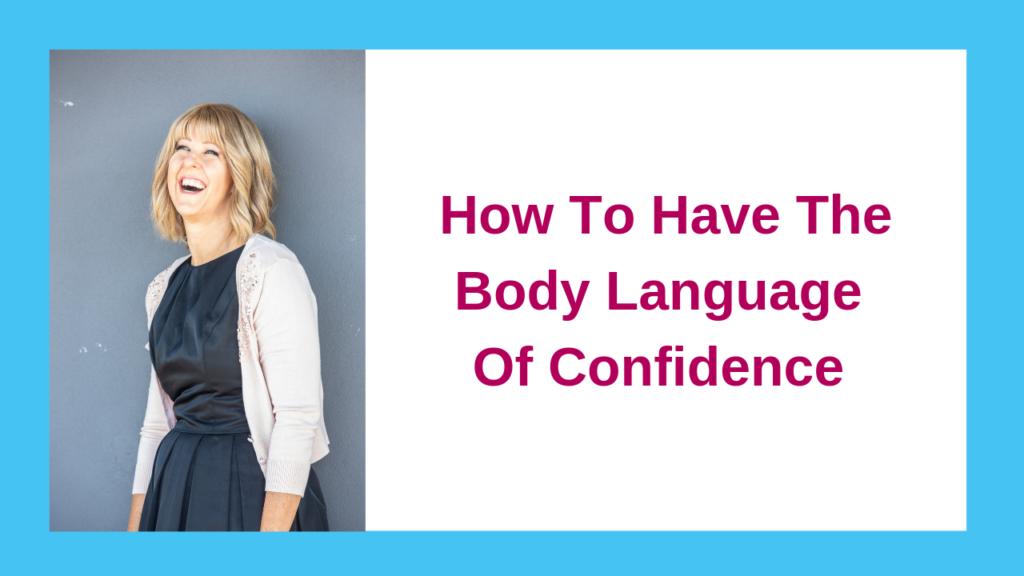
There are 3 main things that make up confident body language.
1. Open body language
When you first meet someone, they are making a first impression of you within about the first few seconds.
People are sizing you up and judging you. We have to, because it keeps us safe, right? We’ve got this in-built judging part of us to protect us, we want to know if that person is trustworthy, if that person is safe.
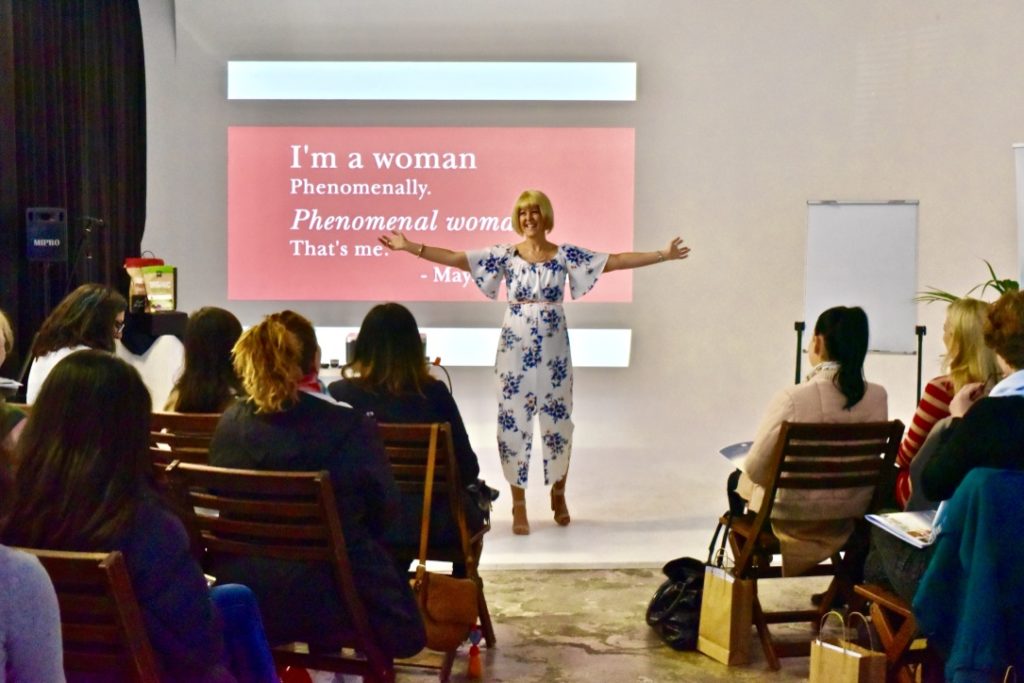 Part of our brain is scanning the body language to make sure that that person can be trusted. The more closed we are, the less confident we look.
Part of our brain is scanning the body language to make sure that that person can be trusted. The more closed we are, the less confident we look.
So when you meet someone at a networking event, for example, if your body language is closed, people automatically, at an unconscious level discount you and lower you in your positioning inside their mind.
When you meet people – are you crossing your arms?
Are you putting your hands behind or body or clasping your hands in front of you?
At an unconscious level, this sends out signals to the person that you’re communicating with that you are not open to them.
And closed people aren’t usually warm, and are usually less trustworthy.
When I get people up in my workshops to stand in front of the group, pretty much everyone closes up, crosses their hands or arms or puts their arms behind their back -whatever it is that makes them feel less threatened.
Closed body language makes you appear more nervous and less confident.
So make sure that when you’re standing talking to someone that you keep your arms at your side, or use your hands purposefully.
It can be a really hard thing to do.
The most important thing you can practice with body language is standing with your arms directly at your side.
I remember as a personal trainer, I was taught when I’m training my client to stand with my arms at my side.
It was one of the hardest habits I had to get out of.
And when I did professional speaker training, they made us stand with our arms by our sides for days when we were presenting, to get us out of that habit of closing our body or fidgeting.
We often just go to this pattern unconsciously and don’t even realise we’re doing it. So you’ve got to train yourself. You need to practice it. It’s probably going to feel weird at first, but practice, practice, practice.
If you’re calm, and certain and confident, then you can easily just hold your hands at your sides.
When you’re in a meeting, when you’re speaking on video, when you’re chatting with a client, are you using open or closed body language?
It matters.
Also, remember to use your hands. Your hands add flavour, interest and colour to what you’re talking about.
Don’t overdo it; don’t be distracting. But just use your hands naturally as where they want to move to.
2. The body language of certainty
 People who are certain about what they’re saying use certain body language.
People who are certain about what they’re saying use certain body language.
Using gestures with your palms down shows certainty.
Using strong hand gestures where your hands are straight and in a natural position with your palms facing each other is also a certain position.
You can also use your hands to drive your point home.
With certain body language, you’ve got to read the situation.
Body language is not ‘one size fits all’, it’s about using what is appropriate for the person or people you’re with.
Standing tall with your head up is also a certain body language pose.
If you’re on stage and you want to come across confident, you want your body language to be bigger.
Certain language is bigger. Compare it to people who are very shy and nervous and awkward – their body language is small and more tucked in. They try and make themselves small to take up less room and not be so seen.
Very confident people try and take up more space.
It’s very similar to the animal kingdom, animals that are trying to exhibit their territory or their power or go really big.
Think of a peacock, or a gorilla beating its chest.
3. Symmetrical body language
 Another body language of confidence is symmetry.
Another body language of confidence is symmetry.
As soon as you tilt your head to the side, as soon you put your lips to one side, or lean on one hip or put your weight on one side, you look less confident.
Asymmetrical posture makes you look more confusion and less confident in what you’re saying.
When we’re certain we have symmetry: our feet are together, we stand with even weight on both feet, and we’re not tilting or leaning or torso or head at all.
If you want to come across more confident in your body language, this is a simple hack that you can apply straight away.
If you’re making an offer to someone, avoid going asymmetrical in your body language.
If you do it too much, you’ve lost it – it’s usually game over.
The body language of confidence is very symmetrical.
It doesn’t mean being stiff and forced. Just bring awareness to it and think about how you may be coming across and being perceived by people.
If you want to come across more confident, if you want to command more respect from people – and you can still do it in a nice, friendly, open, warm way – be symmetrical.
Symmetry is one of the most important parts of confident body language.
It doesn’t mean you’re symmetrical all the time, but when you’re delivering your message or presenting your offer, having enough symmetry in your body language is crucial.
So, to recap the 3 parts of confident body language
1. Open body language
2. Certain body language
3. Symmetrical body language
So, how’s your body language?
Are you being open, certain and symmetrical when you’re making your offers?
The first step is awareness.
I have hundreds more tips on influence and how to attract clients and inspire them to sign-up to what you’re offering.
If you’d like help in this area, I’d like to offer you a free, private 1-1 strategy session.
Together, we’ll create a game-plan on your best next steps to being a more influential business owner who gets results.
Click this link to book your free 45-minute strategy session.
Business is too hard to do alone.
So don’t struggle, make sure you reach out, I’d love to help you overcome your business challenges and get the results you deserve.
Kat
4 Essentials To Attracting and Signing Up Paying Clients
Want to know the non-negotiables you need to attract and sign up new clients?
In this video and blog, I share with you 4 essentials you need to market and sell effectively.
These four essential are non-negotiable if you want your sales and marketing efforts to bring results.
They give you the clarity to make sure that you sign up the right client for you – the ideal clients that you want.
They give you clear direction, so you know exactly what you’re heading, peace of mind, certainty, and predictability.
If you miss even one of these, all of your sales and marketing efforts can fall flat.
1. Plan
The first thing you need is a plan.
A lot of people put off creating a plan because they think it’s just going to sit on the shelf or in the drawer somewhere and not actually refer to it.
That’s not the kind of plan I’m talking about.
I’m talking about a plan that’s an every-day working one-page document that has exactly what you need to do on it for your marketing.
Your plan should start with your values, vision and mission of your business.
And then based on those values, vision, and mission, you chunk it down into goals that you have for the full year, goals that you have for each quarter, and goals for each week and each day.
This way it’s straightforward.
We all know that we should be goal setting and having a plan and having targets, right?
But, do you have one that’s clear and working? How often are you actually looking at your plan and working from it?
A lot of business owners I talk to feel too busy caught up in their day-to-day business. And I totally relate because I can get like this as well.
There are always distractions coming at us. And it can be hard to take that time away to create a plan.
But it doesn’t need to take a long time.
If you’re a business owner, no doubt you have a busy, full life.
It does take time to time out of your every day. But it’s going to save you time in the long-run.
This is part of your marketing is to have a one-page document where you know exactly what type of content you’re putting out, and what your current launches and campaigns you’re working on are.
So many people will say to me “I’m not getting clients coming in, I don’t have a consistent flow of clients”
Without a campaign or launch – where you’re building people up to the launch, opening the doors of the launch, and then you’re closing the door to launch, it’s a struggle.
If people are able to access you anytime – if you’re just available all the time, there’s no scarcity and there’s no urgency.
The reason we want scarcity and urgency is not to just create fake hype about how these limited spaces. That’s not it.
According to Robert Cialdini’s book ‘Influence’, scarcity and urgency are an important part of influence.
In fact, most people will not buy or not make changes unless they feel like they’re going to miss out.
For example, do you have a current offer that’s going to end? Or can people just jump on your website anytime and buy from you anytime?
So deciding that is part of your plan.
It’s really important to have your targets – to know exactly what your goals are.
And I don’t mean “I want to help lots of people and make lots of money”.
I’m talking about numbers by the end of this quarter – how much money exactly do you want to earn?
How many clients do you need?
How many client appointments do you need to make?
How many webinars do you need to do or meetups or workshops – or whatever your marketing strategy is that you need for your plan?
2. Process
The second thing you need is a process to take people from where they are to a paid client.
It’s never going straight from meeting someone and going into a paid client – you need a whole process that people go through.
And what we need to do is get people step-by-step closer to making an offer to them with something that they are going to pay money for.
We never want to do that too prematurely, or we put people off, right?
So there’s got to be a planned, effective process people go through.
There’s some new research that shows that people need to consume seven hours worth of content, on average, from you, before they make a significant buying decision.
They might buy something small, but for them to buy your premium offers, such as your coaching package, or your retreat or your big-ticket offer, people need 7 hours.
That’s a lot of time on Facebook Lives or blogging, or if you’re only doing social media captions – that’s a LOT of posts that you need to build up to that time of seven hours on average.
That’s why I LOVE workshops as a strategy because you can do your seven hours in one day, for people get to know, like and trust you and are willing to purchase if they feel that you have what they can be helped by, right?
If you’re not doing a full-day workshop, if you’re just doing small bits-and-pieces here and there, it takes a lot more time to build up enough of that know, like and trust factor for the purchasing decision.
So it’s really important that you have a process to take someone from where they are to your paid offer.
You are best doing this through automated funnels.
You want to have systems that are automated instead of manually following anyone up, manually booking an appointment, manually getting payments.
We shouldn’t be doing all of those things manually. Your business should be automated and systemised.
It’s not 2001 anymore, you know, we’ve moved on from that – there’s no reason to run a clunky manual business next is sucking your energy, and probably your joy as well.
So you need to have automated funnels set up.
A funnel is basically where someone can opt into through a link. And they do everything themselves rather than you having to contact them all along the way.
We also want to make sure that your automated systems have exceptional client service and experience so that they’re not just getting a robot experience.
You want to have that human experience, that wonderful exceptional client experience with automation.
So they get both, it’s not one or the other. Some people think that if you go automated, that you’re losing the human touch, it doesn’t need to be like that.
In fact, it frees up your time to have even more human touch with them, because you’re not doing all the techie stuff back and forth, it’s all done through technology.
There are really cool systems that you can use for that nowadays, to do things automated.
You also need your effective online strategies in place and offline strategies in place.
You shouldn’t only be looking at online lead generation strategies, but offline lead generation strategies too.
If you do both, you’ve got way more chance of finding your ideal clients and them signing up to your offers.
You need an effective funnel, offline and online lead generation strategies that are unique to your business, and that needs to start with your plan.
3. Presentation
You need a presentation – a way to present people with your paid offer.
Make sure that you don’t do your premium offer presentation when you’ve just met people (unless they are showing clear buying signals, which is rare the first time they meet you!)
You don’t want to go into a sales pitch before people have been able to consume your content and you’ve educated them and shared with them, helped them and given them lots of value.
Your presentation needs to be at the right point in the process.
A presentation could be at the end of…
- A phone call
- A webinar
- A workshop
- At the end of a one-on-one discovery or clarity session
An effective presentation is how we sign up paying clients.
So really take your time to make sure that you have a well-crafted presentation.
Don’t try and wing it. Don’t try just make it up on the spot.
Make sure that you take the time because you don’t want to spend all this money and time of marketing to get to that point of presentation and then blow it.
This usually happens because you’ve just rushed it or you haven’t got to know that person enough or you haven’t educated them enough on the benefits of what you offer.
You can do things like sending them videos before they come on a call with you. They can look through your blogs, they can look through your all your material, watch your videos, etc.
The more content that you have for them to consume, the more likely they’re going to take you up on your paid offer.
4. Personalisation
You need to personalise what you’re doing in your business.
You can’t take the advice of some guru and try to apply it in your own business and expect it to work exactly the same as what they are doing.
You’ve got to make sure that you personalise all the information you’re hearing and reading.
If you’re anything like me, you love researching and going to workshops and seminars and events and learning as much as you can about how to grow your business.
But we can’t just take what you hear from a stage or from a YouTube clip or audiobook, or wherever you are consuming knowledge and expect that it’s going to work exactly the same for you.
You’ve got to personalise it for you. Maybe that means that you need colleagues that you can run your Facebook ads and copywriting and promotional stuff past for feedback before you waste time, money and opportunities.
People scroll past so fast, you need to make sure your content and marketing is effective or it’s a total waste.
Maybe you need a mentor or a coach. If you don’t have support, it’s very hard to personalise what you’re doing to suit you and your unique stage of business.
For example, someone might say the best thing to do next is Pinterest if they’re selling a ‘Grow Your Business With Pinterest’ program.
Or if someone is selling an online course creation course, they might encourage you to do a course so you might think that it’s time for you to design a course – when you don’t even have clients yet.
Or you go to a seminar where someone’s selling a book writing program and you might stop everything to go write a book. But that might not be the best strategy for you right now.
The best strategy for you right now might be building your email list or building your followers on social media.
It could be getting paid clients by getting on the phone, and giving free sessions to people so that you can get to know people’s problems and goals and get some testimonials.
There are so many different things we can do to sell and market.
You’ve got to make sure that you filter everything coming at you for your own unique business – your own style, the way that you want to do it.
Maybe running Facebook ads isn’t the best strategy for you at the moment.
Maybe you actually need to get your branding a little bit better before you start paying for traffic.
And it doesn’t mean perfection – it could just mean that you decide on your brand colors, your emotions, you know who you’re speaking to before you start paying for traffic.
Or maybe it’s not the right strategy for you to spend hours a day in Facebook groups – maybe that sucks your soul and you don’t enjoy that.
You’ve got to personalise all of the things that you could be doing and be really true to yourself and your own personality and lifestyle.
No one knows you as well as you do.
If you want help with personalisation for your sales and marketing, I’d love to offer you a free session where I can help you personalise your strategy, your next decision, your next step.
So if you haven’t had a session with me before, then this a free session for you to get some clarity.
But other ways that you can get personalisation is by seeking out mentors and peers and colleagues, where you’re supporting each other.
Business is too hard to do alone, right?
So those are the four things you need in order to sign up new clients.
The first one is a plan, the second one is a process, the third one is a presentation, the fourth one is personalisation.
You need all four of these things AND they have to be effective for you to sign up new paying clients.
And that’s what I’d love to help you with.
NEXT STEPS
There are a few options you can take to help you to apply these 4 essentials…
1. Jump on a free strategy call with me
Click here to book a private 1-1 strategy call
2. Free online master class ‘How To Attract Your Ideal Clients’
In this webinar, I share my top 3 marketing secrets to attracting new clients in the next 30 days.
It’s on Thursday the 29th of August at 7:30pm.
Learn more about ‘How To Attract Your Ideal Clients’ Free Online Masterclass
3. Full-day workshop in Sydney ‘How To Sell Your Services With Ease’
You will learn everything you need about how to sell your services authentically and genuinely.
You’ll receive a proven, effective sales script template that you can tailor to your business.
You’ll learn how to overcome every single objection you will be presented with and confidently ask for what you’re worth, without sounding pushy.
It’s especially for you if you really don’t like selling!
Learn more about ‘How To Sell Your Services With Ease’ 1-Day Workshop
3 P’s Of Effective Influence
Have you ever wanted to be more influential?
Influence is such a powerful thing. In this video and blog post, I share with you three P’s of effective influence.
Influence: the ability to be a compelling force, or to produce effects on the actions, behaviour and opinion of others.
Influence is the ability to change yourself and others, and positive and authentic influence. It’s about making the world a better place.
I love talking about, learning about, reading about and teaching about influence.
Some people get confused about the word ‘influence’ – they think it’s about being a social media influencer and selling product. And sometimes people view influence as a manipulation tactic.
That’s not the type of influence I’m talking about. It’s about ethically and authentically influencing people.
Influence is NOT about manipulation. It’s not about trying to convince people to do things they don’t want to do.
It’s none of that.
I want to share something that I read in the foreword of Adam Hulahan’s book ‘Influencer’.
It’s by Tim Gates, who’s a global motivation and change conference speaker.
He says:
“It seems to me that most codes of law, ethical principles and spiritual texts all encourage, declare or command the influence of self and of others. Have you noticed that personal and societal development and progress are all governed by a process of influence?”
A great purpose of life is to influence yourself and others to motivate positive change.
If we can influence heart-centred people, people who care deeply about others, people who want the best for other people – the ripple effect is profound.
When you become more influential, you can influence more people to take positive action, and create positive change.
Have you noticed that everything you have, believe, experience and do, who you are, your life – has been shaped and influenced?
We’re always being influenced all the time by other people and things, and we have all our lives.
We can control our future by what we are allowing ourselves to be influenced by today. Who you are today is a product of what influenced you yesterday. Today you can influence your tomorrow.
There are many great ways to influence others and I want to share three powerful ways.
1. Positioning
The way that you position yourself determines how much influence you have over other people.
If you want to truly be an influencer, if you want to have influence in life as a leader, as a thought leader in your area of expertise and in your genius zone, you need to position yourself correctly.
There are different ways that we can position ourselves. What I recommend when it comes to positioning yourself offline and also online is a mixture of credibility and humility.
Credibility + humility. It’s a beautiful combination.
We need to be able to share our credibility with people – we need to share why what we’ve got to say is important, why it matters, why people need to listen and pay attention.
But we don’t want to be tooting our own trumpet to much right?
We don’t want to be always raving on about how great we are, because people don’t like that, they polarise that. If we go on too much about how great we are, we can actually push people away.
So when we bring in humility with the credibility, people really want to listen to what we have to say.
The way you can do this is through your tonality and your body language and the words that you say.
For example, let’s say that you want to share how much experience you have, but you don’t want to sound like you’re bragging.
Remember that people want to know your credibility – they want to know that you’re good at what you do. They want to know your positioning and why they should pay attention to you, why they should be influenced by you, why they should listen to you.
The way you can do this is by using a lower humble tonality.
You don’t want to have really high over-energetic enthusiasm when you’re talking about yourself, because people tend to bring you down a peg in the positioning they have you in, in their mind.
If you say it in a low humble tone and you use your body language to express it in a humble way, people are more open to receiving it.
You can also bring in the people that you are grateful for that have helped you because no one has succeeded on their own.
No-one is a great success without help from friends, mentors, coaches, counselors, teachers or parents – we have all been influenced by people, we’ve all been helped by other people to get into the position that we have.
I learned this from Benjamin J Harvey – I want to give kudos to you Ben, thank you for teaching me this.
The rule is, when you’re talking about yourself, you use low tonality low energy, and you drop the volume in the picture but when you’re talking about them and what’s in it for them, you get more excited and you add more energy to what you’re saying.
You can do this when you’re on stage, or on video as well, you can actually use some of your body language to get more vibrant and expressive when you’re talking about what’s in it for them – the listener, the audience, your followers – whoever is listening to you or watching you.
The next thing to think about your positioning is that it’s kind of like a bank account. I like to think of this analogy where you’ve got an account – it’s a metaphor, and you’re always making either deposits or withdrawals into the people who you want to influence.
So, if you, for example, turn up late for an appointment, you’ve just made a withdrawal from that account. It’s like an influence account and we add and subtract depending on whether you’re making deposits, or when you’re making withdrawals.
Some of this happens at our unconscious level or subconscious level and we don’t realise that we’re actually having this effect on other people.
When you make withdrawals, you lower your positioning in their mind.
We’re always lowering or increasing the positioning that we have in people’s minds, depending on how much we’re giving them, how much we’re serving, how much we’re helping – and how much we’re just taking and asking for ourselves.
We want to make sure that we’re putting in lots and lots of deposits before we make a withdrawal.
That’s why we don’t just walk up to people and invite them to our paid programs – we get to know people first, we make deposits before we make withdrawals.
So we give value, we give content, we teach, we use education-based marketing before we ask for a sale so that people can get to know us, like us and trust us.
The three key ingredients to influence are:
* Being known
* Being liked
* Being trusted
You cannot have effective influence without those three things.
To get your positioning where your known, liked and trusted you need to make sure that you’re giving lots of deposits.
The last thing I want to say about positioning is that you’ve got to remember to prize yourself. It’s called prizing.
You’re the prize.
So I want you to think of it like a cat and a dog.
Unless you’ve got a really crazy cat, which some of you might, I don’t know, but most cats when you get home, they don’t run up to the door and jump on you all excited, as a dog does.
They usually just sit and wait, and lick themselves and be pretty. Typically, they’re not over-excited like a Labrador for example.
So think of that scenario about cats and dogs and the difference between a cat, which knows that they’re the prize – they love to be patted and admired and adored, whereas a dog it’s all about “Please like me, Please like me, Please take me for a walk”
I know there are exceptions, but in stereotypical cats and dogs, be the cat. Be the cat. Because no one can buy you anywhere, except from you. People can get other coaches, other service providers, but they can only get you from you.
You’ve got to value yourself and position yourself as a person of value in order to influence people.
And you can do that by showing your credibility with humility, making deposits and also knowing that it’s not about you just being a nice person and bending over backwards for other people, that’s not what influence is.
It’s being the leader, it’s leading and not being led. It’s being willing to stand up and have a voice and have an opinion and prizing yourself.
Not under-valuing yourself, not under-charging, not giving all these discounts because you’re desperate to get sales, for example.
If says “No, I don’t want what you’ve got” – that’s fine, move on.
You’re not trying to convince them that they need you.
You want to prize yourself and what you offer and only work with people who want to work with you, who are committed, who are willing to learn and change and respect and value your time.
2. Presence
This is about being present. If you want to be influential, you cannot be stuck in the past, or stuck in the future.
When you’re connecting with someone and you’re looking them in the eye and you’re really connecting with them and you’re getting to know them, and you’re asking them questions and actively listening…
…you will not be able to influence them unless you’re hearing – first of all the things that they’re saying, and also the things that they’re not saying.
You’re looking for the non-verbals, the clues and the cues in their body language and in their tonality.
You cannot do this, you cannot notice those small details, the language that they are using it and be able to memorise it, in order to really be able to help them unless you are present.
So when you repeat back to them what they told you to make sure that you understand it correctly – if you’ve been drifting off and thinking about what you’re going to have for lunch.
Or if you’re stuck in the past about what happened to you this morning, maybe you’ve had a stressful morning, you won’t be really super present with them and you won’t be able to influence them.
If you are jumping on the Facebook Live video, and you’re not present because you’ve rushed, maybe you’re still stuck in what happened an hour ago, or because you’re worried about what’s going to be happening tomorrow morning, you won’t be present on that Facebook Live video and people will feel it.
They will feel your stress, and that energy is really frantic, and even if you’re smiling and friendly, people still pick up on those things, energetically.
Even if you try to hide it, it still comes across in the way we speak and in our body language, and the things we say.
So, we’ve got to really be in the moment.
I do this by imagining a bubble around the person that I’m talking to, so I’m not distracted by things going on around us.
I also do it for example like doing a video like this. I’m only thinking about how can I communicate this to the best of my ability. Right now, I’m not thinking about anything else.
When you are truly in the moment, you can be influential.
It does take practice though, right? None of us get it perfect – we’re always going back and forth along our timeline into the past and into the future.
Very few people live completely present. We’re not meant to live completely present all the time – we are meant to be able to draw wisdom from our past and plan for the future, we are meant to be able to look at our whole life and our timeline.
But we need to make sure that when we’re with someone or when we are focused on a task, that we get in that zone and that flow and stay present.
3. Passion
You know how important passion is – imagine trying to be influenced by someone who doesn’t have passion.
Someone with a monotone and crosses their arms and doesn’t care, and isn’t passionate – you pick that up. And it’s not someone that you want to emulate or follow or get excited about.
I like to think of the three E’s of passion
* Emotion – There’s some kind of emotion where this person is moving you emotionally. It’s not just logic, facts, stats and data like a boring University lecture…
It’s actually real-life, relevant topics and there’s emotion attached to it.
* Energy – Passionate people have energy and influential people have energy. And I’m not talking about that hype, fake, over-the-top kind of energy – I’m not talking about that.
I’m talking about charisma, that passion that comes through, people like Will Smith, Jim Carrey, Marianne Williamson, Oprah Winfrey, Tony Robbins…
…they have passion, and they are all different. They’re not necessarily jumping up and down on the stage, although Tony Robbins does, it’s more than that.
People with energy speak with power and certainty and charisma.
* Enthusiasm – People who are enthusiastic about their message are influential. Again, it’s not hypey, it’s not flashy or fluffy, you’re enthusiastic about your topic and care – you deeply care from your heart, about what you’re sharing.
You can always tell when someone’s not passionate about what they do for a job. or about how their day is going. or how their life is going.
You can tell – if they have that spark in their eyes, if they’ve got a spring in their step when they’re loving life and vibing at a really high frequency – you feel that energy.
I remember when I was in my last few years of working in a gym full-time as a personal trainer and that passion had just been slowly reducing and I could feel it.
I would deliver the best sessions that I possibly could and I would be organised and be as enthusiastic and energised as I could, but the spark was really diminished.
Looking back now I can see that it was because I really wanted to do coaching. I wanted to transition out of that training job but I didn’t know how.
I was still studying and thinking about how I was going to make the transition.
There was a period there where I knew that I lost my passion, and I could just feel it – everything, wasn’t as shiny and wasn’t as vibrant, it dulled the experience.
So if you’re feeling like that about what you’re doing, ask yourself “How can I get that passion back?”
Because you’ve got to be an effective influencer, which you need to be if your business owner if you’ve lost that passion.
As a business owner, we need to be able to influence others – because that’s what sales and marketing is all about. It’s the ability to influence people to positive change.
Things that are going to improve the quality of their lives, and help them heal or transform them or save them time or money or bring relief – all those beautiful feelings that come on the other side of positive change.
So those are 3 P’s of effective influence:
1. Positioning
2. Presence
3. Passion
Which one do you need to apply more in your life at the moment?
If you have any questions or comments, please post below.
Would you like to know how to use influence skills to attract clients?
There are a few different options for how I can help you.
If you haven’t had a one-on-one session with me before, then I’d love to offer you a free one-on-one session.
I will help you strategise and put the right systems in place for your business and show you the next steps you need to be doing right now, and how to actually do them.
Or maybe you’ve got these systems in your business already, but they need a few tweaks because they’re not all working as well as they could.
If you don’t have a flow of consistent clients coming through your pipeline and you’re signing them up regularly and then nurturing them so they are raving fans, systems can help you.
You can book in your free session here
Also, I have a full-day workshop coming up on Saturday the 17th of August, in Sydney.
This is for you if you want help putting together your client attraction system to help you attract and sign up clients and keep them coming and paying you consistently so that you can have a profitable business that you love.
You’ll learn the systems you can use to free up your time and stop stressing and struggling over money and getting stuck in procrastination or overwhelm or any of those things that hold us back in our business.
You’ll get loads of useful tips and a step-by-step plan that you can apply straight away, plus a lot of support and a great community.
Learn more about the workshop here
- « Previous Page
- 1
- …
- 31
- 32
- 33
- 34
- 35
- …
- 37
- Next Page »
